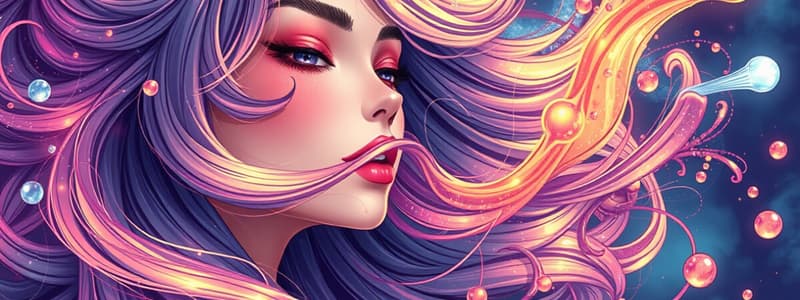Podcast
Questions and Answers
What are the four chemical reactions that take place during permanent waving?
What are the four chemical reactions that take place during permanent waving?
A disulfide bond joins the sulfur atoms in two adjacent polypeptide chains. Permanent wave solution breaks a disulfide bond by adding a hydrogen atom to each of its sulfur atoms. The sulfur atoms attach to the hydrogen atom from the permanent waving solution, breaking their attachment to each other. Once the disulfide bond is broken, the polypeptide chains can form into their new curled shape. Reduction breaks disulfide bonds and oxidation reforms them.
What is the difference between an alkaline wave and a true acid wave?
What is the difference between an alkaline wave and a true acid wave?
Alkaline Waves (Cold Waves) have a pH between 9.0 and 9.6 and use ammonium thioglycolate (ATG) as the reducing agent, processing at room temperature. True Acid Waves have a pH between 4.5 and 7.0, require heat to process, and use glyceryl monothioglycolate (GMTG) as the active ingredient.
Why do permanent waves need to be neutralized?
Why do permanent waves need to be neutralized?
Neutralization stops the action of the waving solution and rebuilds the hair into its new curly form.
How do thio relaxers straighten the hair?
How do thio relaxers straighten the hair?
How do hydroxide relaxers straighten the hair?
How do hydroxide relaxers straighten the hair?
What is curl re-forming and how does it restructure the hair?
What is curl re-forming and how does it restructure the hair?
Flashcards
Permanent wave process
Permanent wave process
A chemical process that changes the hair's shape from straight to curly or wavy
Alkaline wave
Alkaline wave
Permanent wave using ammonium thioglycolate (ATG) at room temperature.
Acid wave
Acid wave
Permanent wave using glyceryl monothioglycolate (GMTG) with heat; lower pH.
Neutralization (permanent wave)
Neutralization (permanent wave)
Signup and view all the flashcards
Thio relaxer
Thio relaxer
Signup and view all the flashcards
Hydroxide relaxer
Hydroxide relaxer
Signup and view all the flashcards
Study Notes
Chemical Reactions in Permanent Waving
- Disulfide bonds link sulfur atoms in adjacent polypeptide chains.
- Permanent wave solution adds hydrogen atoms to sulfur, breaking disulfide bonds.
- Newly formed polypeptide chains can adopt a curled shape.
- Reduction reactions break disulfide bonds, while oxidation reforms them.
Alkaline Waves vs. True Acid Waves
- Alkaline Waves: pH between 9.0 and 9.6, use ammonium thioglycolate (ATG) as the reducing agent, require no heat for processing.
- True Acid Waves: pH between 4.5 and 7.0, require heat to process, use glyceryl monothioglycolate (GMTG) with slower processing time and generally tighter curls compared to alkaline waves.
Importance of Neutralization
- Neutralization halts waving solution activity and reinforces hair's new curly structure.
Thio Relaxers
- Thio relaxers function like permanent waves by breaking disulfide bonds and softening hair.
- After sufficient bonds are broken, hair straightens to a new shape, followed by rinsing.
Hydroxide Relaxers
- Hydroxide relaxers permanently break disulfide bonds differently, through lanthionization.
- A sulfur atom is removed from the disulfide bond, converting it to a lanthionine bond, which contains only one sulfur atom.
- Hair treated with hydroxide relaxers cannot be re-styled into permanent waves as the original disulfide bonds cannot be re-formed.
Curl Re-forming
- Curl re-forming enlarges and loosens existing curls without straightening the hair.
- Soft curl permanents utilize a thio-based service to transform curly hair into larger, looser curls.
- The process involves wrapping hair on rods and uses ammonium thioglycolate (ATG) and oxidation neutralizer similar to thio permanent waves.
Studying That Suits You
Use AI to generate personalized quizzes and flashcards to suit your learning preferences.




